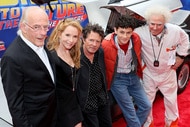Create a free profile to get unlimited access to exclusive videos, sweepstakes, and more!
Science Behind the Fiction: gen:LOCK and the development of real world mech suits

Mech suits have long been the object of our sci-fi affections. They first appeared in fiction during the late nineteenth century within the pages of books written by Edward Ellis, Jules Verne, and H.G. Wells. But they really found a home later on with manga, anime, and video games (not to mention one very memorable fight between Ripley and an angry mama xenomorph).
The latest addition to this long tradition is gen:LOCK, an animated dystopian-future series from creator Gray Haddock that attracted some big Hollywood names, including Michael B. Jordan, Dakota Fanning, Maisie Williams, and David Tennant. The series, produced by Rooster Teeth and Jordan's own production company, Outlier Society Productions, tells the story of the Earth, 50 years in the future, on the edge of war.
What follows is a high-tech battle including advanced fighter jets, walking tanks, drones, and swarms of nanobots. And mechs. We can't forget the mechs.
It's an image of warfare that, while decidedly futuristic, feels totally real in its potential. Science fiction is perfectly suited for exploring the extremes of human ability and gen:LOCK does just that, showcasing incredible technological ingenuity while doubling down on our violent shortcomings.
We may not yet be flying around in Iron Man suits or fighting kaiju from within the heart of giant robots, but mech suits are, at long last, on the horizon. And the tech we're creating isn't just for fighting alien invaders.
A BRIEF HISTORY OF MECH SUITS
General Electric, the company most commonly known for making household appliances, was an early contender in the powered suit arena. GE might be most recognizable for the logo on your microwave, but appliances actually only make up a small percentage of its operating profits. In another universe, GE might have been known as a successful military contractor, though it's not doing so bad on that front in this reality, either.
Beginning in the 1950s, GE made a series of powered, human-piloted robotic suits for military and civilian applications. Sadly, none of them ever made it off the production floor. The company's first attempt was the Handyman, developed by engineer Ralph Mosher. It consisted of two parts, controls worn by the pilot and a pair of clawed robotic hands that mimicked the user's movements.
Photos exist of the Handyman twirling a hula hoop and wielding a hammer during a press conference. Sadly, however, there is no video because, apparently, no one thought to roll camera while Mosher wrestled a fantastic future into reality.
Taking what he learned on this project, Mosher moved on to bigger and better things. The Hardiman suit was funded by the United States military and, according to General Electric, had the ability to lift up to 1,500 pounds. The machine, however, ran into stability and power-supply problems and was ultimately scrapped.
Third time's the charm, though, right?
The Cybernetic Anthropomorphous Machine (CAM) was a four-legged rugged terrain vehicle developed in 1965. Bearing a striking resemblance to Star Wars' AT-AT, the CAM responded to movements from a pilot situated inside the belly of the beast. In addition to being the coolest thing that side of the Moon landing, it was impressive both in its strength (the below video shows the pilot kicking a truck out of the way) and its delicacy. Pilots received feedback from the vehicle by means of pressure on the controls, allowing them to exert as much or as little force as desired.
In the end, like its predecessors, the CAM was scrapped. It used upward of 50 gallons of oil per minute, necessitating a constant flow from hydraulic lines. It also drove its operators a little crazy from mental exhaustion arising from controlling its four independent limbs.
Ultimately, the programs of the '50s and '60s were disbanded and the machines left to rust. We had the will but our technological know-how wasn't ready to realize such big dreams. A lot has happened since then, though. Surely we're ready to fight Godzilla, topple buildings, or at least play giant-sized Rock 'Em Sock 'Em Robots.
THE CURRENT STATE OF MECHS
The military is still interested in powered exoskeletons, though the emphasis seems to have moved toward making life easier for the everyday soldier. A number of companies are working on suits that would serve to reduce the strain of carrying large loads, rather than enhance the innate abilities of the wearer.
But that doesn't mean we aren't still working on more complex systems. For years the U.S. Special Operations Command has been working on a high-tech exoskeleton more in line with our sci-fi imaginings.
TALOS, which stands for Tactical Assault Light Operator Suit and is named after bronze automaton from Greek mythology, aims to outfit soldiers with full body armor, enhanced strength, and increased situational awareness via a heads-up display. At current, there is no official release date as the project has run into problems in development.
Outside of military applications, exoskeletons have been and are being developed for therapeutic reasons.
The Phoenix exoskeleton, developed by SuitX, consists of a lower body device that controls the movement of the legs and hips. It is intended for individuals with spinal injuries, allowing them to walk by way of buttons embedded into the handles of compatible crutches. It is essentially an alternative to a wheelchair, travels at just over one mile per hour, and has an eight-hour battery life.
In terms of real-world usability and convenience, these paired down devices hit the mark but something visceral is lost. Gone are the overbearing and intimidating robotic suits from fiction, replaced with cold practicality.
Don't you worry your squishy, biological head, though. Wherever there is a dreamer with money to burn, you'll find a machine stupefyingly wonderful. Enter the Method series of mech suits from South Korea's Hankook Mirae Technology. CEO Jin-Ho Yang enlisted designer Vitaly Bulgarov to help him lift giant robots straight out of comics and into real life.
For years, Bulgarov worked on movies and video games, designing fictional technology for franchises like Transformers and RoboCop, but this time he was designing something real.
Bulgarov's bona fides show in the end result. The Method exoskeleton looks like something you'd expect to see on a movie set. Standing at 12 feet tall, Method has a cockpit large enough for a pilot to sit inside and is capable of lifting one-and-a-half metric tons.
For now, Method remains tethered to a power supply but Yang plans to add a three-hour battery life to make it truly independent.
Method is a passion project for Yang, who has invested roughly $200 million of his own money to bring it to life, though he hopes it will have applications for disaster relief.
While Method still has many kinks to work out before it's ready to hit the world stage, there's something truly satisfying just knowing it exists alongside its more practical mechanical companions.
Considering the advancements made in wearable robotics over the past 50 years since GE's Handyman, one can only imagine what might happen over the next five decades while we continue to pursue the merging of biology and technology. We'll just have to wait and see.
gen:LOCK is available now from Rooster Teeth.


























